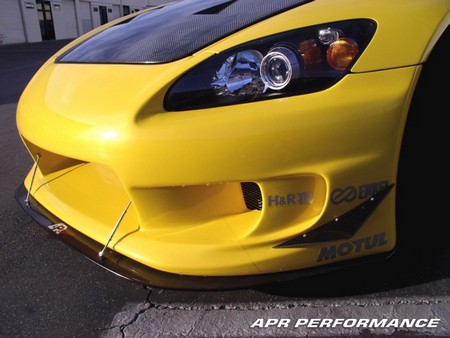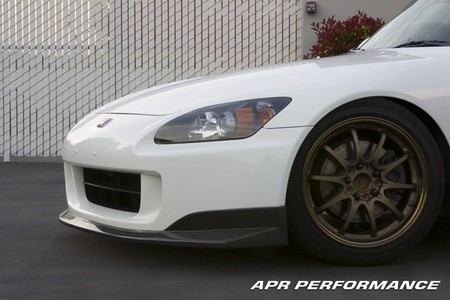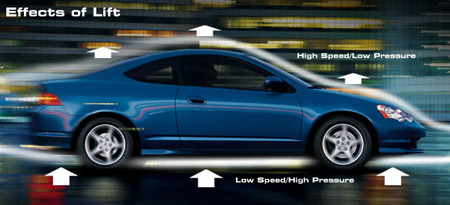Compatibles: (6.2L)
2015 - 2023 Dodge Challenger SRT Hellcat
Features:
Underbody components such as front air dams, undertrays, and rear diffusers are essential for maximizing aerodynamic performance.
The APR Performance Front Air Dam integrates with the factory front bumper to:
- Reduce lift.
- Increase front-end stability
- Improve high-speed cornering grip
Splitters

What is a splitter:
A splitter (a.k.a. "front splitter") is typically found on the front-end of a race car, appearing as a flat extension to the very bottom of the front bumper. This splitter extends straight out, parallel to the ground, and can be made of carbon fiber or other stiff material. It is attached to the bottom of the front bumper, and may also be supported by two or more support rods at some distance forward of the bumper mounting points. These support rods ensure that the splitter stays parallel to the ground, even when there are outside forces around the splitter.
What is an air dam: An air dam (a.k.a. "front air dam") is usually a shaped part of the lower portion of the front bumper. It is sometimes called a "front lip" or "lip spoiler." It can be molded as part of the front bumper, or it can be a separate part that is attached at the front-lower portion of the front bumper. Unlike the splitter, the lip is not a flat "sheet" of material.
An air dam (a.k.a. "front air dam") is usually a shaped part of the lower portion of the front bumper. It is sometimes called a "front lip" or "lip spoiler." It can be molded as part of the front bumper, or it can be a separate part that is attached at the front-lower portion of the front bumper. Unlike the splitter, the lip is not a flat "sheet" of material.
Besides looking cool, the splitter and air dam serve the following functions:
1. To reduce lift.
2. To help guide air to a useful location (i.e. radiator).
What goes on at the front-end of a car: When a car travels at high speeds, the air pressure in front of the car can become very high. All this air ends up going both above the car (over the hood), and below the car (under the front bumper). When too much of this air gets under the front bumper, the under-car air pressure builds up. This increased air pressure contributes to lift, which causes the front-end of the car to lighten up, thereby reducing the amount of traction at the front of the car. This high pressure (and lower speed) air, when compared to the air speed above the car, will create situation where there is increased lift over the entire car. Typically, most production street cars, when traveling at higher speeds (60mph+) produce large amounts of positive lift.
When a car travels at high speeds, the air pressure in front of the car can become very high. All this air ends up going both above the car (over the hood), and below the car (under the front bumper). When too much of this air gets under the front bumper, the under-car air pressure builds up. This increased air pressure contributes to lift, which causes the front-end of the car to lighten up, thereby reducing the amount of traction at the front of the car. This high pressure (and lower speed) air, when compared to the air speed above the car, will create situation where there is increased lift over the entire car. Typically, most production street cars, when traveling at higher speeds (60mph+) produce large amounts of positive lift.
How the front splitter and front air dam work:
What we want to have is lower pressure, faster-moving air below the car, and higher pressure, slower moving air above the car. The lower pressure side, when it happends to be under the car, contributes to reduced lift. When the lift is reduced sufficiently to the point where there is negative lift, then there is net positive downforce.

The splitter (or air dam) itself does not actually create downforce. What the splitter does is that it increases the area over which high pressure can build up. The more high pressure there is above the splitter, the greater the net downforce there is. Additionally, if there are openings in the front bumper (above the splitter or lip) for brake ducts or radiator cooling, this increased air pressure will encourage more air to flow into these openings.
When are splitters and air dams effective:
Splitters (and air dams) are effective when they are mounted close to ground level, and when they extend beyond the bottom of the front bumper. This maximizes the pressure area above the splitter, and maximizes the pressure differential between the top and bottom sides of the splitter.
When the splitter is mounted very close to ground level, considerations should be made to ensure that:
1. There is sufficient airflow to the engine bay and driveline components.
2. There is sufficient ground clearance for the available suspension travel.
3. The rear diffuser (if installed), still gets the fast-moving, low pressure air it needs in order to function properly.
Install Guide:
Warranty:








